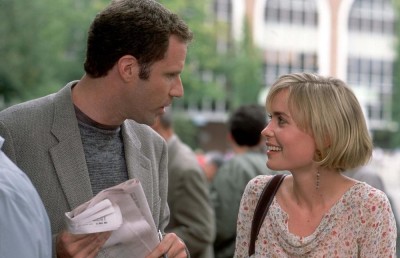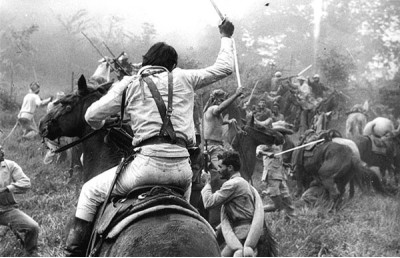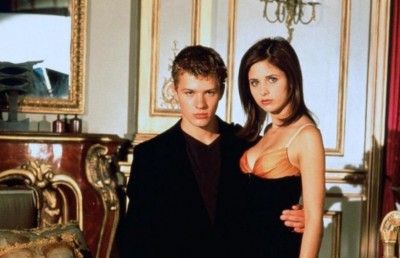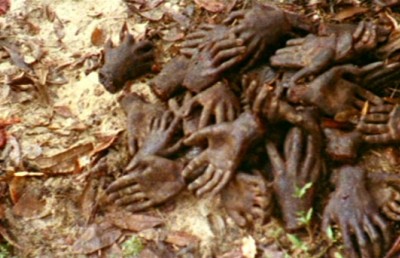Tsai Ming-liang Retrospective
Tsai Ming-liang at the Cinematheque
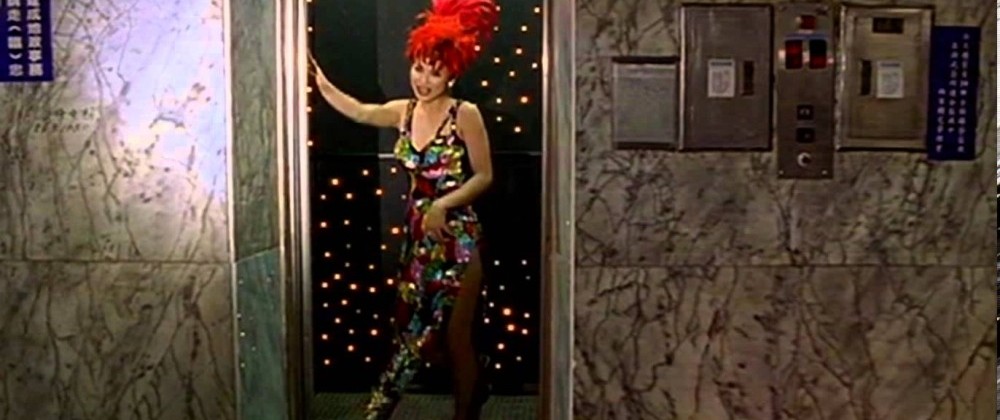
In mid-April Montreal’s La Cinémathèque featured a complete retrospective of the works of Malaysian-born Taiwanese director Tsai Ming-liang. What made this retrospective especially enticing was the screening of two features which had never shown in Montreal, Goodbye, Dragon Inn (2003) and his most recent film, The Wayward Cloud (2005), plus several shorts which had also never shown in Montreal. In total there were seven feature films screened and four short films. In this summary review I will concentrate on these previously unseen films.
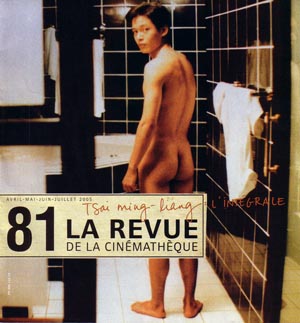
The retrospective included Tsai’s first two short features, both made for television and shot on video: All the Corners of the World (1989) and The Boys (1991). Both are minor works of interest for the presence of Lee Kang-Sheng in The Boys and the sort of melodramatic narrative in All the Corners of the World that he would never return to. The latter does bear some affinity to his later works in the depiction of dysfunctional families (Rebels of the Neon God, The River). The film follows a lower working class family of scalpers, a mother, father, son, daughter, and senile grandfather. The daughter gets in with the wrong crowd, a pimp, and tries to challenge her parents’ authority by courting the pimp’s advances (and accepting his gifts). When a trip to the motel turns sexually aggressive she breaks a bottle and stabs him in the chest. The family is shattered that their daughter is embroiled in such an affair, so blind are they to their own delinquent behaviour serving as a bad role model. The pimp later dies in the prison, and the film ends with the daughter being carted off by the police, with her teary eyed mother at curbside. More touching is her younger brother, who she too has alienated with her alleged acts of prostitution, who forgets about his anger and drives after her on a moped, crying and yelling out her sister’s name. The one point that sticks out in comparison to his later films, is that there is none of the alienation of his later works and that there is more of an emotional engagement with the characters than in his later works (and Tsai Ming-liang is clearly on the side of the under classes).
In The Boys Lee plays a teenager who blackmails an elementary school kid for his money. In the end he gets his comeuppance when he is treated to some of his own medicine by an older group of blackmailers who target him in a fast food restaurant. It was nice to see a young Lee Kang-Sheng in the type of taciturn role he would later repeat in more mature works, but this, too, was minor Tsai Ming-liang.
Getting on to major Tsai, Goodbye, Dragon Inn is one of the most enchanting films ever made about cinema, and perhaps the greatest feature length film to be shot almost entirely inside a movie theatre (granted there aren’t a whole lot of contenders….Lamberto Bava’s Demons 1986…?).
There are three things that Tsai Ming-liang celebrates in Goodbye, Dragon Inn, and that form the focus of the film:
1) The great Taiwanese director King Hu, whose film Dragon Inn happens to be the film playing in the cinema, and which represents the final film to be screened at this particular theatre. Among the handful of people in the theatre are two actors from the original film, Shih Chun and Tien Miao, calmly (and with teary eyes in one touching moment) watching their forever young cinematic alter egos. The two actors meet briefly just outside the cinema lobby and exchange a few words which reflect the film’s sense of nostalgia for a dying cinema-going culture: “Nobody remembers us now. No one comes to the movies anymore.”

2) The theatre itself, beautiful when darkened and screen-filled; ugly and cold when fully lit and in-between screenings. In many respects the film is not about the film on the screen but the nooks and crannies of the theatre: the labyrinth corridors and crawlspaces behind the front screen; the side doors to the screen; the barely cleaned bathrooms; the steep stairs leading to the projection booth; the box-office area. Like in his other films, it is raining very hard on this, the night of the theatre’s closing. Pails are placed strategically to gather falling rain from holes and cracks in the ceilings, a not so subtle suggestion that the theatre has been left to die a slow death. It is often said that cinema is a social art, to be enjoyed in company, but in Goodbye Dragon Inn the theatre is a lonely place inhabited by lonely people. Tsai Ming-liang brings his usual isolation/alienation style (little dialogue, static long takes, long shots) into the theatre. The way the club-footed female employee shuffles about the theatre and watches snippets of the film from the most unlikely of places recalls the sense of sadness and loneliness captured in Edward Hopper’s classic painting New York Movie (1939).
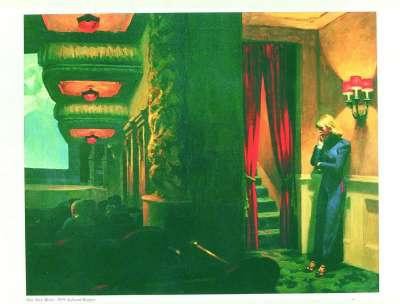
The empty theatre is even granted ‘tribute’ status by being accorded the film’s longest take. After the film-within-the-film ends, the female employee turns on the house lights. The few people leave and she walks up and down the aisles looking for garbage. She exits frame left and the camera lingers on the empty/frame, empty/theatre for several minutes.
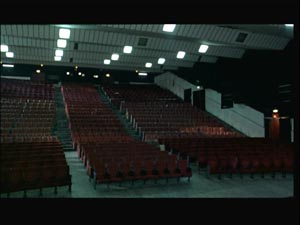
3) The third element which Tsai focuses on are the sad, lonely losers and alienated urbanites who frequent the cinema in a vain search for some form of human contact. They are all laconic and barely even acknowledge the presence of other humans. The club-footed female cashier/manager goes all the way up to the booth with a piece of cake for the projectionist, but is never greeted for her favor. The lonely Japanese tourist (Kiyonobu Mitamura) seems to be cruising, but is equally content sniffing men rather than touching them; and the noisy, peanut eating woman sneaks up behind the Japanese man and frightens him away (a Japanese character also appears in The Wayward Cloud, as a female porn star). Fittingly, Tsai’s perennial actor Lee Kang-sheng is the mute projectionist who draws the theatre’s steel shutters closed for the last time. People often point to Lee as being Tsai’s alter-ego but in this case the Japanese man may be a better model. Tsai was born in Malaysia and moved to Taipei when he has 20. He has mentioned how he felt caught between the two places, which would seem to relate to the Japanese man.
Moreso than his most recent film, The Wayward Cloud, Goodbye, Dragon Inn, ranks up with his other great works (The River, The Hole) where formal rigor is concerned. Music is used sparingly, as is dialogue. As is the norm for most of his films, there is more “diegetic” dialogue from onscreen sources (televisions, radios, cinema screens) than from character mouths. And the visual style is marked by a long take/static camera and precise framing and composition that often serves to underscore the lack of communication among the central characters. The theatre is something of a male cruising spot, where a man will sit right next to another man in an empty theatre and likewise take up a bathroom stall next to an occupied stall, when all other urinals are free. But again the male cruising seems a sham, since the men can at best exchange fertile glances, rub against each other as they pass by in narrow corridors, with nothing of any consequence transpiring; accept perhaps in the hilarious long take in the bathroom, where three men stand next to each other at the urinals for what seems like an eternity, nobody being able to break away; while in the background we see a man enter a closed stall and then leave, and a few seconds later the ajar stall door is slammed shut by someone inside.
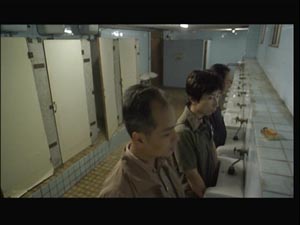
The seedy theatre brought back memories of a dive theatre on lower St. Laurent street called the “The Crystal,” which used to show triple bills for under two dollars in the 1970s. I would never go to the theatre alone, and my friends and I would always ‘cover’ for each other when going to the washroom to guard against the leering middle-aged men loitering about.
This extreme long take is similar to an earlier long take in the theatre, where the duration and the framing underscore Ming-liang’s unique ‘comedy of social discomfort’ by placing characters in tight, confined claustrophobic social spaces, the sort of space that would make an already shy and socially awkward person, as is the Japanese character, feel even more uncomfortable. The camera frames the Japanese man seated alone. Another man behind him to his right but partially off-frame places his bare feet up on the back of the seat next to the Japanese man, about six inches from his face. A few moments later a second man sits next to him on his left. The sense of discomfort the Japanese man now feels is palpable, as he squirms in his seat, glancing at the feet to his right, and the man to his left.
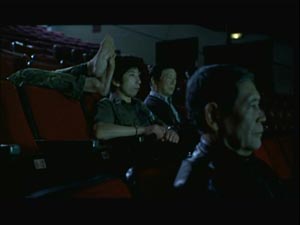
Goodbye, Dragon Inn was shown along with a 20 minute short from 2002 entitled Le pont n’est plus là / The Skywalk is Gone. The same themes are present: characters alienated in an urban environment. The opening long take is of a busy Taipei street corner, with people and cars bustling left and right, movement everywhere except for one woman, back to the camera, entranced by a huge advertising screen on the side of a building. Again, as in The Wayward Cloud and Goodbye Dragon Inn, the dialogue comes from a mediated source (a television, the jumbo advertising screen, the cinema). She eventually walks away, looking for the missing titular bridge to cross the busy intersection. It is gone, so she manages to jaywalk across. This extended opening sequence recalls Jacques Tati’s Playtime in the way the woman is ‘lost’ among the reflective surfaces of the city. We often don’t know if we are seeing her true visage or a reflection off a glass door, wall, or mirror. The woman’s path crosses that of Lee Kang-Sheng on a subway staircase. The short now follows the man, as he goes to a job interview for the role of a porn actor. The potential employer casually asks the young man to strip and then to masturbate. The applicant is not able to comply with the second request, and suggests he do it elsewhere. Throughout this scene he is reflected through a smeared, window-paned door. When the employer asks him what he does for work he replies: “I sell watches on the bridge.” This character and exchange looks ahead to his next two films, What Time is it Over there? where he plays a character who sells watches on a commuter bridge, and The Wayward Cloud, where he plays a porn actor, in which he also mentions the job as a watch seller.
The Wayward Cloud (2004) is an interesting development for Tsai in that it continues his long take/static camera style, although with less formal rigor than his other mature works, and adds more humor than in any previous work. But the fascinating thing is how the comedy becomes a device that sets up the powerful final scene, which plays off the previous comedic tone and becomes more powerful because of it. In the opening scene a woman dressed as a nurse is laying spread eagle with half of a red watermelon on her vagina. A man, the eponymous Lee Kang-sheng as porn actor Hsiao-Kang, joins her and begins licking the melon. The woman reacts as if contact is being made directly on her sex. The man begins to finger the melon, and her moans increase as if nearing orgasm. The scene cuts further back to the foot of the bed to frame the ridiculous image of the Lee character wearing the melon on his head, looking toad-like, and sexually servicing the woman. We don’t see anything to suggest this is a ‘film within a film’ but in hindsight, it probably is, when we see other behind the scene pornographic moments. Although we don’t see any conventional behind-the-scenes elements in this opening, the tone of the later behind-the-scenes sex footage is similar to the tone in this opening scene (comedic, absurdist).
In an opposite scenario to The Hole, where it rained continuously, television notices tell us that it hasn’t rained in weeks, and water is becoming scarce. Which sets up a hilarious behind-the scenes pornographic scene in the shower, where the shower’s water stream is replicated by a man slightly off camera pouring water over the fornicating couple with a watering jug. But before an orgasm is achieved they run out of water, ruining the scene. In a later scene, the same Japanese woman is masturbating with a plastic bottle but looses the bottle cap inside her vagina. Hsiao-kang is the only one capable of removing it (fitting, since he’s the character most familiar with that particular body part).
Although the sex scenes function as a parody of the porno film, the cumulative effect of the sex recalls Antonioni’s great alienation tetralogy (L’Avventura, L’Eclisse, La Notte, and Deserto rosso) where sex was an empty signifier of moral and spiritual decadence amongst the Italian bourgeoisie. The social class in the Tsai film is lower, but, like in the Antonioni films, what the characters lack in their life spiritually or morally they search for, unsuccessfully, in sex. Here the alienated character, Hsiao-Kang, gets all the sex he wants, but it is ‘fictitious,’ and in fact he seems unable to have sex off-camera with an equally alienated librarian named Shiang-chyi (Chen Shiang-chyi), who he has struck a relationship with. Shiang-chyi lives in the same apartment complex where Hsiao-Kang ‘works’ and, try as she may, she is unsuccessful in her attempts to seduce him into coitus. Hence connection of even the physical kind is impossible (since they never talk).

After chuckling most of the way through the film, Tsai pulls the carpet out from under his audience by shifting to an emotionally wrenching conclusion. The librarian, who is unaware that an apartment in her complex is being used to make pornographic films, finds the Japanese woman in an unconscious stoned or drunk state in the elevator. She drags her into her apartment. By chance, she puts on one of Hsiao-Kang’s porn DVDs and spots the Japanese woman starring in the film. She drags her out of her apartment, where she is met by one of the porn producers searching for her “star.” He finds her and drags the Japanese woman onto the set where they are ready to film. The show must go on and they decide to proceed with the filming even though the actress is one step removed from unconscious. What follows is a series of absurd moments where the crew members and director take turns propping the woman up, spreading her legs, and keeping her in serviceable sexual positions, while Hsiao-Kang thrusts away as if nothing was out of the ordinary. Whereas the earlier sex scenes were punctuated by the Japanese woman’s high pitched moans and grunts, now there is a sickening silence. Whether conscious or not, the scene is a striking critique of the male sex industry, where the woman is, literally, treated like a ‘slab of meat.’ Whether the woman is conscious or unconscious does not seem to make a difference. At some point into this dark and sick sex scene the librarian happens across a round portal looking into the apartment where the sex scene is being filmed and begins looking through the opening. The camera at one point cuts to a startling composition where we can see Hsiao-Kang thrusting from behind and the only other person who he has made any type of human contact with, framed in the background peering in through the small round window. Our first interpretation of what Shiang-chyi must be feeling is sheer anger; anger at the sight of seeing Hsiao-Kang make love to a comatose woman, when he hasn’t been able to make love to her. And anger at how a woman is being treated. But rather than carry through on any drama which may result from these emotions, there is a powerful moment where eye contact is established between Hsiao-Kang and Shiang-chyi. Shiang-chyi begins to moan and groan, as if dubbing the missing voice of the Japanese woman. Rather than disgust, she is getting aroused by the sight of the sex exchange, as if physically experiencing the pleasure in some form of surrogate sex. Or scopohilic desire ten-fold. The moment echoes the opening scene, where the Japanese woman was getting ‘off’ without actually being touched (the melon scene). The sexual tension between them is so powerful that Lee seems to float across the bed (in a jarring jump cut) and thrusts his pubic area up against the portal opening. Shiang-chyi has taken his penis inside her mouth. The scene cuts to one of the most disturbing and uncomfortable long takes I have ever scene: an extreme close-up profile shot of Shiang-chyi with Hsiao-Kang’s pubic hair pressed up against her face. Stillness reigns for what felt like approximately five minutes. The shot finally gives way to a long shot behind Shiang-chyi. First one arm and then the other falls limp to her side, as if to suggest emotional/physical exhaustion; or perhaps death by suffocation!
Whereas laughter was present and acceptable in all the earlier sex scenes, this final sex scene seems designed to dare the audience to laugh. You think the sex is funny, well laugh now, is what Tsai seems to be attempting. And in fact the shift in tone was palpable in the audience I saw it with. No one was laughing. As the audience slowly made their way out, people seemed stunned (granted, the scene would no doubt elicit a different reaction in another context, like the Fantasia Film Festival, for example).
The Tsai Ming-liang film which The Wayward Cloud comes closest to is The Hole: with the bizarre musical number excursions (five in this one) and the importance of the single set apartment building, where both man and woman live and where the porn films are made. Although the level of queasiness and discomfort during the latter sex scene recalls a similarly devastating moment toward the end of The River, where the father and son realize that they have inadvertently engaged in sex at a gay bath house (also fellatio). With these latter two works heaped onto a filmography that already included exceptional works such as Rebels of the Neon God, The Hole, The River and What Time is it Over There?, Tsai has solidified his position as one of the most important filmmakers of his generation.



